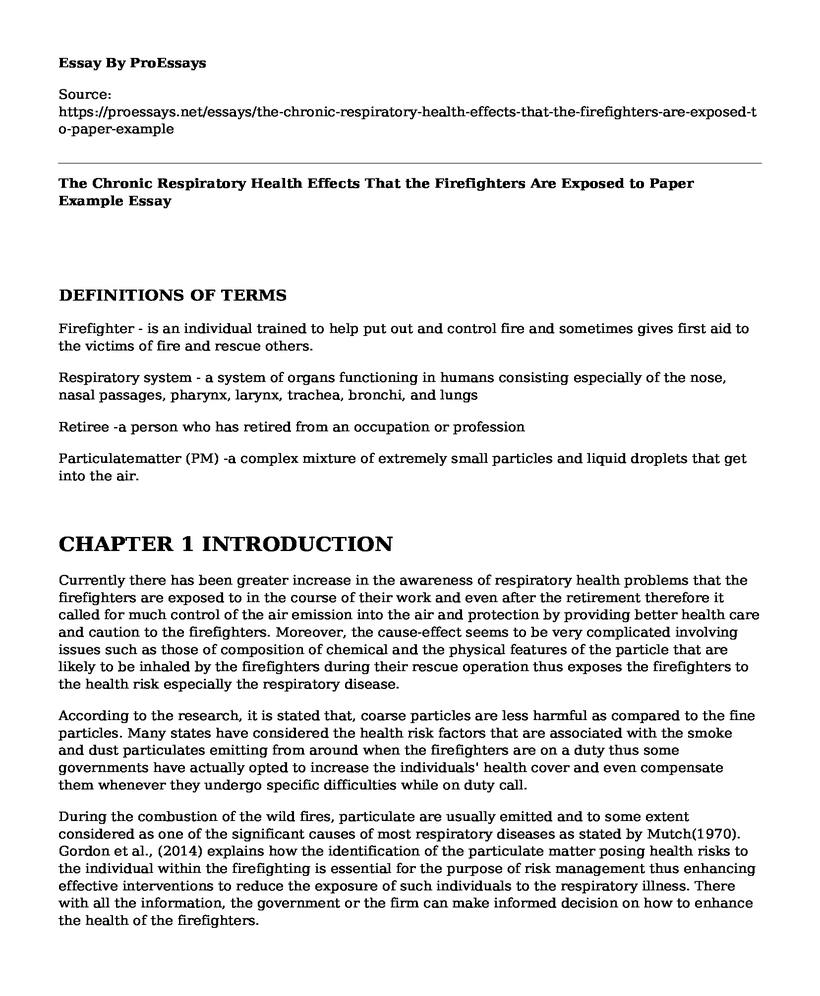DEFINITIONS OF TERMS
Firefighter - is an individual trained to help put out and control fire and sometimes gives first aid to the victims of fire and rescue others.
Respiratory system - a system of organs functioning in humans consisting especially of the nose, nasal passages, pharynx, larynx, trachea, bronchi, and lungs
Retiree -a person who has retired from an occupation or profession
Particulatematter (PM) -a complex mixture of extremely small particles and liquid droplets that get into the air.
CHAPTER 1 INTRODUCTION
Currently there has been greater increase in the awareness of respiratory health problems that the firefighters are exposed to in the course of their work and even after the retirement therefore it called for much control of the air emission into the air and protection by providing better health care and caution to the firefighters. Moreover, the cause-effect seems to be very complicated involving issues such as those of composition of chemical and the physical features of the particle that are likely to be inhaled by the firefighters during their rescue operation thus exposes the firefighters to the health risk especially the respiratory disease.
According to the research, it is stated that, coarse particles are less harmful as compared to the fine particles. Many states have considered the health risk factors that are associated with the smoke and dust particulates emitting from around when the firefighters are on a duty thus some governments have actually opted to increase the individuals' health cover and even compensate them whenever they undergo specific difficulties while on duty call.
During the combustion of the wild fires, particulate are usually emitted and to some extent considered as one of the significant causes of most respiratory diseases as stated by Mutch(1970). Gordon et al., (2014) explains how the identification of the particulate matter posing health risks to the individual within the firefighting is essential for the purpose of risk management thus enhancing effective interventions to reduce the exposure of such individuals to the respiratory illness. There with all the information, the government or the firm can make informed decision on how to enhance the health of the firefighters.
Working under massive exposure to Particulate matter, by-products that result from combustion cause a wide scope of pulmonary diseases in firefighters. Studies show that firefighters are more vulnerable to respiratory illnesses as compared to other individuals Soteriades et al. (2011). Moreover, research concludes that the rate at which casualty cases are reported In the firefighting department has increased tremendously. As the fatalities increase, so does the overall number f deaths reported, and the more the number of families suffer. The IAFF has recently enacted laws that in cases of death, the firefighters' family has a right to be compensated, and also retirement benefits are mandatory.
The above situations are termed as employment related hence should be taken with keen consideration. Not only is the lack of compensation an unfair occurrence, but it also leaves the family destitute, affecting even the overall economy of the society. Early diagnosis is a paramount way of preventing fatalities and in some cases, death. This can be achieved by having the respective departments in the fire fighting companies do thorough background medial check and physical examinations to ensure that only the best and healthiest candidates are hired. Occasional medial checks can also play a major role in ensuring that these illnesses are caught in due time hence treatment is availed. Studies have shown that in most cases, fire fighters that have for a long time in the fire department are more likely susceptible to the pulmonary illnesses as they are progressively exposed to them. The estimated number of fire fighter deaths is estimated to be high as of 2007(Kales) from the latter report, it is also evident that most of these victims are ones who have worked longer in the fire department.
An example of this fact is case study Izbicki et al. (2007) involving three firefighters who arrived at a dispatched scene. The particular building had a fire on the second floor therefore the officer put a ladder to the window on the second storey. This was to enable him push through an uncharged hose line, into the hallway. The firefighters themselves used an alternative door and eventually arrived on the affected Area. One of the firefighters directed the hose line towards the ceiling where there was immense smoke. This was done after...
Cite this page
The Chronic Respiratory Health Effects That the Firefighters Are Exposed to Paper Example. (2022, Oct 23). Retrieved from https://proessays.net/essays/the-chronic-respiratory-health-effects-that-the-firefighters-are-exposed-to-paper-example
If you are the original author of this essay and no longer wish to have it published on the ProEssays website, please click below to request its removal:
- Health of Older Adults
- Essay Sample on Injury and Death Investigations
- Disability in Higher Education: The Self-Identification Challenge- Essay Sample
- Research Paper on Malnutrition: Devastating Effects from Birth to Adulthood
- Cholera: A Waterborne Disease & Its Seasonal Patterns - Essay Sample
- Inpatient Falls: Prevention Strategies for Patient Safety - Annotated Bibliography
- Essay Example on COVID-19: Identifying the Problem Before Opening the Unit







